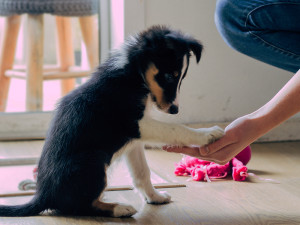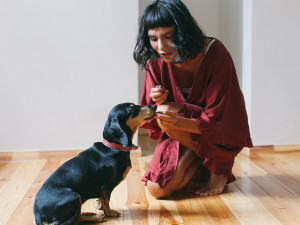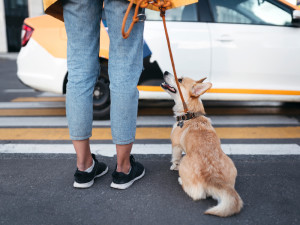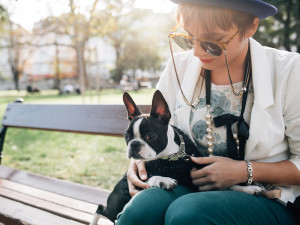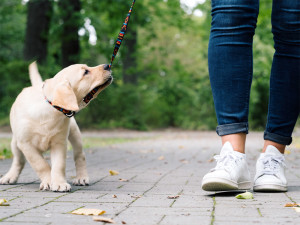How to Find the Right Trainer, No Matter What Your Dog’s Been Through
With so many dog trainers out there that it can be hard to know who you can actually trust (especially if your dog has trust issues of their own), here’s where to start…
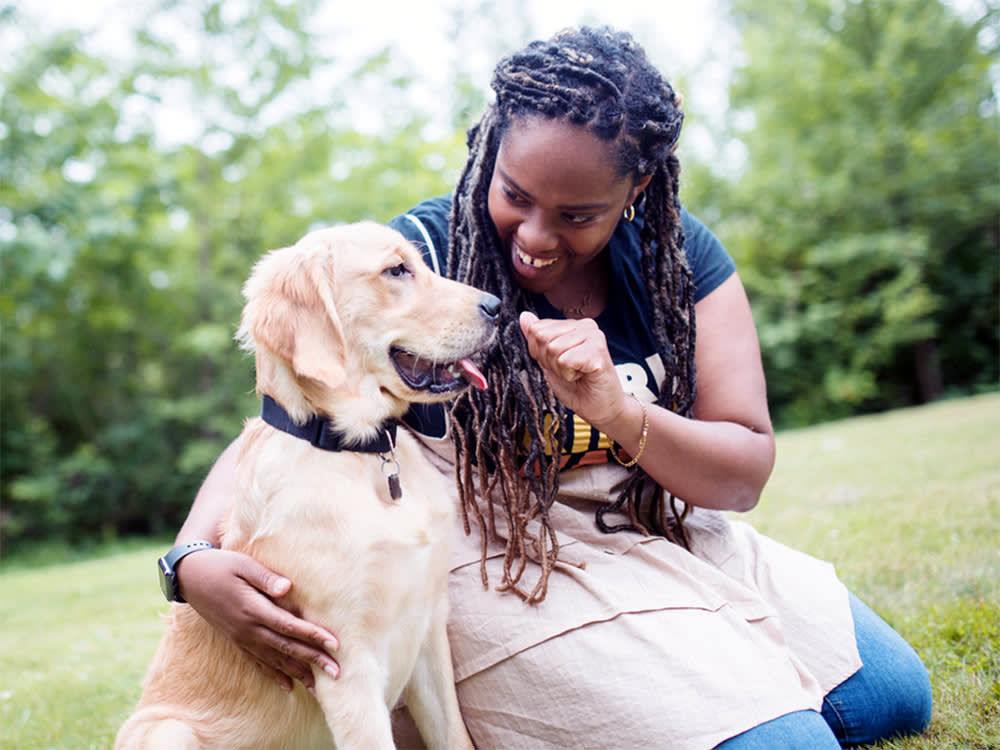
share article
Your new dog is settling into their home and now you want to start some training. You’ve typed ‘dog trainers near me’ into Google, but it’s left you with more questions than answers: shall I book a traineropens in a new tab or behaviourist? What’s the difference anyway? Do I need puppy socialisation classes or one-on-one sessions for my rescue dogopens in a new tab? It’s hard to know where to begin.
That’s how I felt when I needed a professional for my rescue dog Lucyopens in a new tab. She’s – what they call in the industry – a ‘ reactive dogopens in a new tab ’, lunging and barking at scary things (lorries, bikes, joggers) on our walksopens in a new tab and has a hatred of new people coming to our houseopens in a new tab. Thankfully, our rescue centre guided us to find the right kind of training for her. Here’s what I learnt along the way.
Should I get a dog trainer or a behaviourist?
First up, and rather unhelpfully, there’s zero regulation in the dog trainingopens in a new tab industry in the UK. “Anyone can call themselves a dog trainer,” says Rebecca Hanlon, from Speak Dopens in a new tab ogopens in a new tab, which provides education for trainers and owners. “There’s no law against that.” Lynne Spencer, founder and chairperson of charity, Give A Dog A Homeopens in a new tab, echoes this: “There’s no overall governing body.”
However, there’s lots to consider. For a start, the difference between a trainer and a behaviourist. “In general, a trainer teaches a behaviour while a behaviourist fixes it,” explains Lynne. “For example, a behaviourist may be needed to get to the root of why a dog is barking, while a trainer will teach the dog an alternative behaviour.”
Rebecca agrees. “Trainers guide your dog in life skills,” she explains, things like making sure your dog can be off lead in the park by teaching recallopens in a new tab. Rebecca uses the analogy of a school teacher. If you want to train your dog to do agility workopens in a new tab, for example, you’re looking for a trainer who’s the equivalent of a PE teacher. In contrast, Rebecca describes herself as a behaviour practitioner – which you can think of as “a mental health practitioner”, she says. Owners seek out behaviourists if they’re having more complex issues with their dog, “often caused by mental health problems or even painopens in a new tab”, says Rebecca.
“That’s why behaviourists should have a higher level of qualification than a trainer, often they’ll have a degree,” explains dog behaviourist Karen Danceopens in a new tab BSc. More on that later.
What types of training methods are there?
The key is to look into how they will train your dog.
Positive reinforcement or force-free trainers: always look for these types of trainers says Rebecca. “They’ll reward behaviour rather than punish it,” she explains. A reward-based trainer will find what motivates your dog, most likely treats (I still never leave the house with Lucy without a pocket full of chicken!), but it could also be toysopens in a new tab or playing.
Aversive trainers: avoid a trainer who uses aversive methods at all costs. “Things like shock collars, choke chains and prong collars,” says Rebecca. These work by inflicting pain or fear as a punishment for unwanted behaviours – a positive trainer will never use these kinds of tools – and although they might work in the short-term, they can actually cause problems such as aggression and stress in the long-term.
Balanced trainers: “There’s also what’s called ‘balanced’ trainers”, says Rebecca – while balance might be good in other aspects of life, it’s not when it comes to your dog. “These trainers use positive reinforcement most of the time, but when they fail to deal with a situation, they’ll turn to aversives.” For example, they might use a lead correction – “where the lead is pulled as a short sharp shock,” explains Rebecca. Other aversive techniques might be a tap on the nose, pushing down their bums to make them sit and even shouting. “Making our dogs feel uncomfortable isn’t a method of teaching,” explains Rebecca.
What qualifications should my dog trainer have?
Rebecca recommends having a look for professionals who’ve trained with the Dogenius Instituteopens in a new tab, the Victoria Stilwell Academyopens in a new tab, any educational provider that’s force-free or even someone with a qualification that’s OfQual-approvedopens in a new tab. You can also search for tested trainers and behaviourists who only use ethical methods via the Institute of Modern Dog Training (IMDTopens in a new tab), The Association of Pet Dog Trainers (APDTopens in a new tab) and The Pet Professional Guild British Islesopens in a new tab.
If you’re looking for a behaviourist, choose someone certified by The Association of Pet Behaviour Counsellors (APBCopens in a new tab) and who’s a Certificated Clinical Animal Behaviourist (CCAB), says Rebecca. “The highest level of behavioural qualification is the Clinical Animal Behaviourist,” explains Karen. “They'll have at least a degree or FHEC level 6 academic qualification relevant to clinical animal behaviour.”
It's important to make sure you’ve ruled out any illness or physical issues in your pup before embarking on a modification plan. A behaviourist should also have a relationship with a vet so they can help with this. Rebecca, for example, has a relationship with three different vets and she’ll refer dogs to them if she thinks they’re suffering with chronic pain.
Red flags to look for in your dog trainer
Phew, so you’ve rounded up a list of potentials who all use force-free methods. What now? Lynne recommends meeting anyone before you actually book in. “Maybe ask for a trial session or go along to observe a class,” she says. “Any reputable person will allow observation before booking.”
And if you end up in a group classopens in a new tab, “you should always be with your dog”, says Lynne. “Never give your dog’s leadopens in a new tab to a trainer for them to take the dog elsewhere.” That’s a big no-no. “You are your dog’s advocate at all times. Your dog invests all their hard-won trust in you but not in strangers – and a trainer might use punitive methods when they are out of sight.”
But Lynne notes that she’s a big believer in the power of the right group class. “They reinforce socialisation for both dog and human,” she says. “And they enable your dog to start to trust other humans.” Dogs are naturally social animals, so group classes aid their learning – “Supplemented with individual sessions if needed,” adds Lynne.
Anyone who promises a ‘quick fix’ or a fixed timeline is a massive red flag, says Rebecca. “It’s a marketing strategy,” she says, “all they want is your money.” This kind of attitude treats all dogs as if they’re the same. “It will be different for every dog,” she says. “And for group puppy classes, make sure there’s no more than six dogs. Plus, make sure they don’t let the dogs off lead to play unless they’ve assessed all their personalitiesopens in a new tab.”
Lynne also recommends steering clear of anyone who uses language such as ‘dominant’, ‘pack leader’ or ‘alpha’. This kind of mentality is archaic, even though you might see it on TV. “Beware of these kinds of TV programmes,” says Lynne. “Think sceptically about how many hours of training were cut in order to show the ‘miraculous’ results.”
And remember to actually enjoy the classes, reminds Lynne. Do your homework in between sessions, too: “It’s brilliant bonding time,” she says. “You could even work on getting a qualification for your dog, too – for example, a Kennel Club Good Citizen Awardopens in a new tab.”
Most importantly, trust your instincts. I took my rescue dog Lucy to a group class in a park. The trainer told me to attach her lead to the railings and slowly walk away. Every fibre in my being screamed at me that wasn’t right for her. She’d already been abandoned once and I didn’t want her to think that was happening again. I walked away from that class instead of away from Lucy and found a behaviourist to work with instead. You know your dog better than anyone else, so make sure you both enjoy the ride.
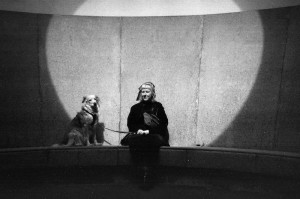
Alice Snape
Alice Snape is a freelance writer and editor whose work has featured in Cosmopolitan, Metro, Red, Vice, amongst other publications. Her rescue dog Lucy is the love of her life – probably because she’s an anxious weirdo like her. You’ll likely find them both curled up in bed – Alice’s favourite place to write from – or out having an adventure together in the park…
Related articles
![Dog lying on a brick street with a leash]() opens in a new tab
opens in a new tab“Why Won’t My Dog Walk Outside?”
Dog behaviourist Karen B London’s 7 tips to help get your parked pet moving
![weird dog rolling in poop]() opens in a new tab
opens in a new tab7 Weird Dog Behaviours Explained
Chasing their tails, eating grass and rolling in rubbish – should you worry?
![Dog looks up at owner on a walk through the city]() opens in a new tab
opens in a new tab7 Ways to Stop Your Dog From Scavenging On Walks
If your dog tries to wolf down literally everything in sight, you need this advice
![a nervous dog sits on a sofa]() opens in a new tab
opens in a new tabBringing Home A Very Nervous Rescue Dog – A Guide For Anxious Parents
At so many points in those first hours, weeks, months, I screamed, internally: what have we done?
![Stylish woman sitting on a bench with her Boston Terrier dog.]() opens in a new tab
opens in a new tabHere’s Why Your Dog Is Terrified of New People
And how to change it
![Woman sitting in a cafe with her dog.]()
Can Your Shy New Rescue Dog Become a Social Creature?
With patience and positive reinforcement, you can do a lot to make up for lost time with socialisation
![Golden retriever puppy chewing and pulling on lead as pet parent tries to walk them]() opens in a new tab
opens in a new tabHow to Tackle Common ‘Pandemic Puppy’ Issues
Turns out, humans weren’t the only ones affected
